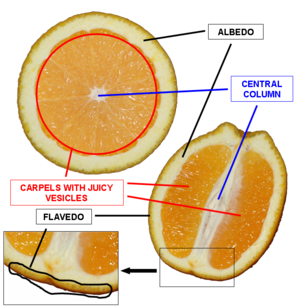Fruit (plant structure): Difference between revisions
ce |
m Interlanguage link with anchor |
||
| Line 67: | Line 67: | ||
[[Category:Fruit morphology]] |
[[Category:Fruit morphology]] |
||
[[ru:Плод#Строение плода]] |
|||
Revision as of 23:18, 12 December 2013
Fruit anatomy is the internal structure of fruit, the mature ovary or ovaries from one or more flowers. In fleshy fruits, the outer and often edible layer is the pericarp, which is the tissue that develops from the ovary wall of the flower and surrounds the seeds. Some plants commonly called "vegetables" such as the cucumber, squash, and tomatoes are actually botanically fruits.
In some seemingly pericarp fruits, the edible portion is not derived from the ovary. For example, in the fruit of the ackee tree, the edible portion is an aril; and in the pineapple several tissues from the flower and stem are involved.
Categories of fruits
Fruits come in three main anatomical categories:
- Simple fruits are formed from a single ovary and may contain one to many seeds. They can be either fleshy or dry. Examples of simple fleshy fruits are berries, drupes, and pomes. Examples of dry fruits include nuts.
- Aggregate fruits are formed from a single compound flower and contain many ovaries. Examples include raspberries and blackberries.
- Multiple fruits are formed from the fused ovaries of multiple flowers. An example for a multiple fruit is pineapple.
Anatomy of simple fruits



In berries and drupes, the pericarp forms the edible tissue around the seeds. In accessory fruits, other tissues develop into the edible portion of the fruit instead, for example the receptacle of the flower in apples.
Pericarp layers
The pericarp itself is typically made up of three distinct layers: the epicarp, which is the most-outside layer or peel, the mesocarp, which is the middle layer or pith, and the endocarp, which is the inner layer surrounding the hollowed ovary or the containing seeds.
Epicarp
Epicarp (Gr. "outside" + "fruit"), is a botanical term for the outermost layer of the pericarp (or fruit). The epicarp forms the tough outer skin of the fruit, which bears oil glands and pigments. The epicarp is sometimes called the exocarp, or, especially in citruses, the flavedo.
Flavedo is mostly composed of cellulosic material but also contains other components, such as essential oils, paraffin waxes, steroids and triterpenoids, fatty acids, pigments (carotenoids, chlorophylls, flavonoids), bitter principles (limonene), and enzymes.
In citrus fruits, the flavedo constitutes the peripheral surface of the pericarp. It is composed of several cell layers that become progressively thicker in the internal part; the epidermic layer is covered with wax and contains few stomata, which in many cases are closed when the fruit is ripe.
When ripe, the flavedo cells contain carotenoids (mostly xanthophyll) inside chromoplasts, which, in a previous developmental stage, contained chlorophyll. This hormonally controlled progression in development is responsible for the fruit's change of color from green to yellow upon ripening.
The internal region of the flavedo is rich in multicellular bodies with spherical or pyriform shapes, which are full of essential oils.
Mesocarp
Mesocarp (Gr. "middle" + "fruit") or sarcocarp ("flesh" + "fruit"), is the botanical term for the succulent and fleshy middle layer of the pericarp of a fruit, between the epicarp and the endocarp; it is usually the major part of the fruit that is eaten, for example, mesocarp makes up most of the edible part of a peach, and a considerable proportion of a tomato. This term may also refer to any fruit that is fleshy throughout.
In a hesperidium such as a citrus fruit, the mesocarp is also referred to as albedo or pith. It is the inner part of the peel which is commonly removed before eating.
Endocarp
Endocarp (Gr. "inside" + "fruit"), is a botanical term for the inside layer of the pericarp (or fruit), which directly surrounds the seeds. It may be membranous as in citrus where it is the only part consumed, or thick and hard as in the stone fruits of the family Rosaceae such as peaches, cherries, plums, and apricots.
In nuts, it is the stony layer that surrounds the kernel of pecans, walnuts, etc., and that is removed prior to consumption.
In citrus fruits, the endocarp is separated into sections, which are called segments. These segments are filled with juice vesicles, which contain the juice of the fruit.

Anatomy of grass fruits
The grains of grasses are single-seed simple fruits wherein the pericarp (ovary wall) and seed coat are fused into one layer. This type of fruit is called a caryopsis. Examples include cereal grains, such as wheat, barley, and rice.
See also
- Gynoecium
- Hesperidium
- Juice vesicles
- Peel (fruit)
- This article incorporates text from a publication now in the public domain: Chisholm, Hugh, ed. (1911). Encyclopædia Britannica (11th ed.). Cambridge University Press.
{{cite encyclopedia}}: Missing or empty|title=(help)
